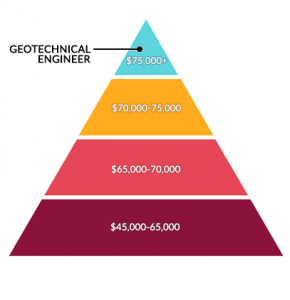5 Easy Facts About Geotheta Described
5 Easy Facts About Geotheta Described
Blog Article
The Definitive Guide for Geotheta
Table of ContentsFascination About GeothetaFascination About GeothetaThe Main Principles Of Geotheta Some Of Geotheta9 Simple Techniques For Geotheta

They conduct site investigations, accumulate examples, carry out research laboratory tests, and assess information to assess the viability of the ground for construction tasks - Geo Tech Engineering. Based upon their findings, geotechnical engineers give referrals for structure design, incline security, maintaining frameworks, and reduction of geotechnical hazards. They work together with various other experts, such as designers, architectural designers, and building teams, to make sure that geotechnical factors to consider are incorporated right into the total project style and execution
By examining the actions and buildings of soil and rock, they can identify prospective geotechnical threats such as landslides, dirt negotiation, or slope instability. Their proficiency aids stop failings or crashes that could jeopardize lives and building. Below are some thorough tasks and responsibilities of a geotechnical designer: Website Investigation: Geotechnical designers conduct website investigations to collect data on subsurface problems.
They interpret the data to understand the buildings and actions of the dirt and rock, including their stamina, leaks in the structure, compaction qualities, and groundwater problems. Geotechnical Evaluation and Design: Geotechnical designers evaluate the information accumulated during site examinations to analyze the stability and suitability of the website for building and construction jobs. They carry out geotechnical computations and modeling to review variables such as birthing capacity, negotiation, incline stability, side earth stress, and groundwater flow.
What Does Geotheta Mean?
Structure Layout: Geotechnical engineers play a vital duty in developing structures that can safely support the intended structure. They analyze the dirt conditions and tons demands to identify the suitable foundation kind, such as shallow structures (e.g., grounds), deep foundations (e.g (https://triberr.com/geotheta)., heaps), or specialized methods like dirt improvement. They take into consideration factors such as negotiation restrictions, bearing capacity, and soil-structure communication to develop optimum structure styles
They examine building strategies, monitor website activities, and carry out field examinations to validate that the style referrals are adhered to. If unforeseen geotechnical concerns arise, they assess the scenario and supply referrals for remediation or adjustments to the style. Danger Assessment and Mitigation: Geotechnical engineers evaluate geotechnical threats and threats connected with the task website, such as landslides, liquefaction, or soil disintegration.

Partnership and Communication: Geotechnical designers work closely with other professionals associated with a project, such as engineers, structural designers, and building and construction teams. Effective communication and collaboration are vital to integrate geotechnical factors to consider into the general task style and construction procedure. Geotechnical engineers supply technical competence, response queries, and make sure that geotechnical requirements are satisfied.
Geotheta Can Be Fun For Everyone
Right here are some kinds of geotechnical engineers: Foundation Engineer: Foundation designers focus on creating and evaluating foundations for frameworks. They evaluate the dirt conditions, lots demands, and site features to figure out the most suitable foundation type and layout, such as shallow structures, deep structures, or specialized techniques like heap foundations.
They examine the aspects influencing incline security, such as dirt buildings, groundwater problems, and incline geometry, and create techniques to prevent slope failures and reduce risks. Earthquake Engineer: Earthquake engineers focus on assessing and creating frameworks to hold up against seismic forces. They assess the seismic threat of a website, assess dirt liquefaction capacity, and create seismic layout requirements to make certain the safety and resilience of frameworks during earthquakes.
They perform field screening, accumulate samples, and evaluate the collected information to identify the dirt residential properties, geologic formations, and groundwater problems at a site. Geotechnical Instrumentation Designer: Geotechnical instrumentation designers concentrate on tracking and measuring the actions of soil, rock, and structures. They mount and preserve instrumentation systems that monitor elements such as dirt negotiation, groundwater levels, incline movements, and architectural displacements to assess performance and provide early cautions of possible issues.
Geotheta - Questions
They conduct examinations such as triaxial tests, loan consolidation examinations, straight shear examinations, and leaks in the structure tests to gather information for geotechnical analysis and design. Geosynthetics Engineer: Geosynthetics designers specialize in the design and application of geosynthetic products, such as geotextiles, geogrids, and geomembranes. you could try here They make use of these products to boost dirt security, enhance inclines, offer drainage options, and control disintegration.
They often tend to be investigative individuals, which indicates they're intellectual, reflective, and investigative. They wonder, methodical, logical, analytical, and rational. A few of them are additionally social, indicating they're kind, generous, cooperative, patient, caring, valuable, understanding, skillful, and pleasant. Does this sound like you? Take our free profession examination to learn if geotechnical engineer is among your leading profession suits.
In the workplace atmosphere, geotechnical engineers use specialized software application devices to carry out calculations, produce layouts, and evaluate data. They prepare records, review project specs, interact with customers and employee, and coordinate job activities. The workplace setting provides a favorable setting for research, analysis, and partnership with other experts involved in the job.
The 5-Minute Rule for Geotheta
They regularly check out project websites to perform site investigations, assess geotechnical conditions, and gather data for analysis. These brows through include traveling to various places, sometimes in remote or tough surfaces. Geotechnical designers might execute soil tasting, conduct examinations, and monitor building tasks to make sure that the geotechnical elements of the task are being implemented appropriately.
Geotechnical designers additionally operate in specialized geotechnical laboratories. In these facilities, they carry out experiments, do tests on soil and rock samples, and analyze the engineering residential properties of the products. Geotechnical lab designers function thoroughly in these environments, dealing with testing devices, running instruments, and tape-recording information. They team up with other laboratory team to make certain precise and trustworthy testing outcomes.
Report this page